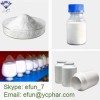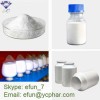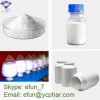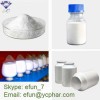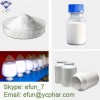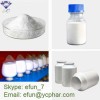CAS. NO 96827-07-5
Synonyms :peg MGF,Mechano ,IG-F-1 EC
Molecular :Formula C121H200N42O39
Molecular Weight :2948.15+(1800-2000)
Purity:99%
Standard:2mg/vial, 10vials/kit
Appearance:White Powder
Packing:Discreet Package
Storage :Lyophilized Peg MGF is stable at room temperature for 90 days,however it should be stored in a freezer below -8C for any extended period of time. After reconstituting Peg MGF should be refrigerated at temperatures not to exceed 36 F.
Usage:Human Growth
Description:
MGF is derived from IG-F-I but its sequence differs from the systemic IGF-I produced by the liver. MGF is expressed by mechanically overloaded muscle and is involved in tissue repair and adaptation. It is expressed as a pulse following muscle damage and is apparently involved in the activation of muscle satellite (stem) cells. These donate nuclei to the muscle fibres that are required for repair and for the hypertrophy processes which may have similar regulatory mechanisms.
The C-terminal peptide MGF, an alternatively spliced variant IG-F-1, was found to function independently from the rest of the molecule. At any rate, IG-F-I exists in multiple isoforms (tissue-specific proteins of functional and structural similarity). One isoform, which differs from the systemic or liver type, happens to be particularly sensitive to mechanical signals such as the gamut of exercise overload. MGF is a local splice variant of IG-F-I produced by damaged or loaded skeletal muscle.
The physiological function of MGF was studied using an in vitro cell model. Unlike mature IG-F-I, the distinct E domain of MGF inhibits terminal differentiation whilst increasing myoblast proliferation. Blocking the IG-F-I receptor with a specific antibody indicated that the function of MGF E domain is mediated via a different receptor. The results provide a basis for localized tissue adaptation and helps explain why loss of muscle mass occurs in the elderly and in dystrophic muscle in which MGF production is markedly affected.
HOW TO USE MGF:
When you train, what happens to your muscles is they break down, the cells are damaged, muscle tissue needs to be repaired and your body produces 2 forms of MGF splice variant. The first initial release of the above mentioned number 1 variant from the liver helps muscle cell recovery, if there is no MGF then muscle cells die.
As muscle is a post-mitotic tissue and as such cell replacement is not a means of tissue repair, if the cells are not repaired they die and your muscles get smaller and weaker. In muscle tissue, the pool of these stem cells is apparently replenished by the action of MGF, which is produced as a pulse following damage.
Now, with synthetic injections of MGF you can increase the pulse and so speed up recovery, and increase the muscle tissue cells by stimulating satellite cells into full maturity. In terms of dosages, 200mcg bi-laterally is the very best choice of dosing in muscles trained.
The only problem with MGF, and this is the reason I don't like it, is that it has such a short half life, just a few minutes, between 5-7, and it needs to be used immediately post workout as it wont work if muscle tissue hasn't been damaged. That's why, for me personally, I think the best option is PEG MGF.
Nevertheless, MGF has a huge role to play, and is administered to those with muscle wasting diseases and for those who are elderly and have lost muscle mass for good reason, it is EXTREMELY anabolic.








